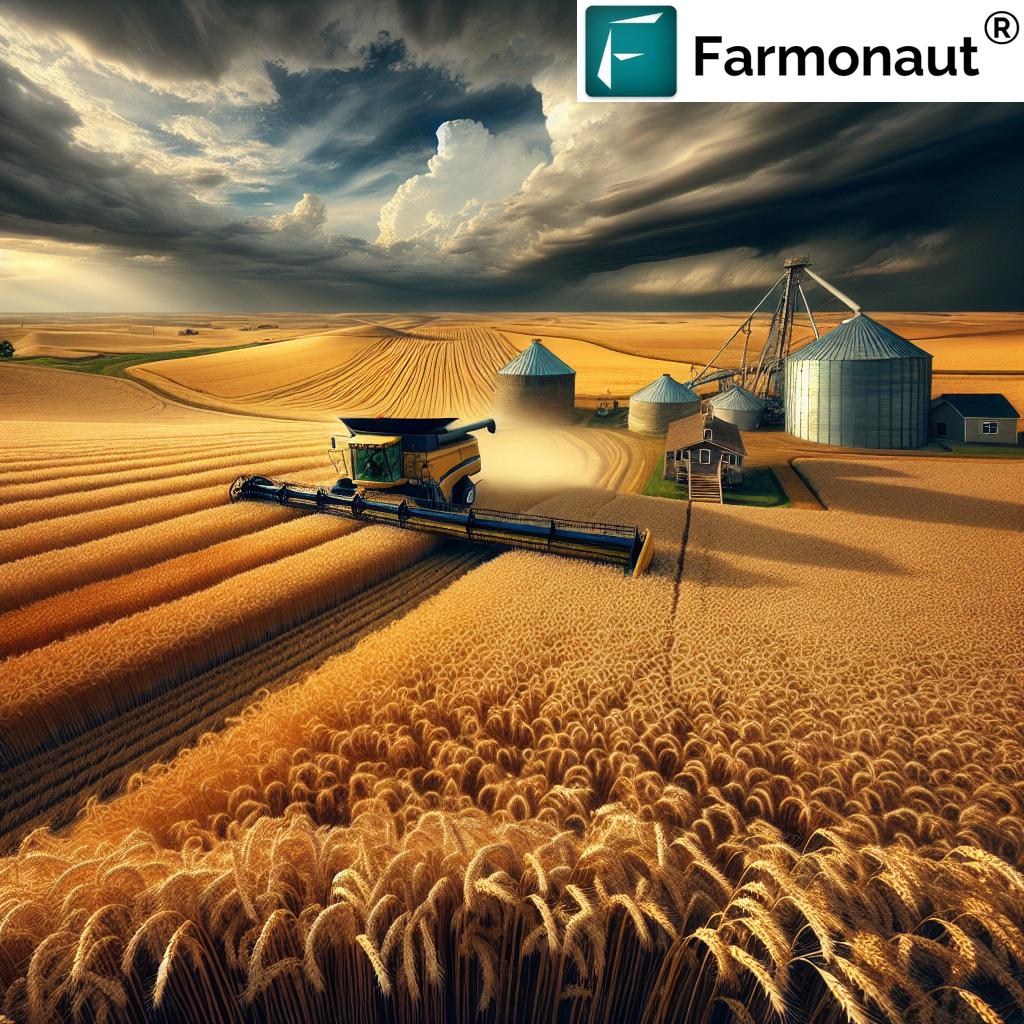Average Wheat Yield per Acre in Kansas & India 2025: Trends, Advances & The Role of Agricultural Loans
Meta Description: Understanding the average wheat yield per acre in Kansas and India is crucial for food security and sustainable farming. Explore 2025 forecasts, technology, and how agriculture loans in Kansas boost productivity.
Table of Contents
- Understanding Wheat Yield and Its Global Importance in 2025
- Trivia: 2025 Wheat Yields and the Power of Loans
- Average Wheat Yield per Acre in Kansas 2025
- Average Yield of Wheat per Acre in India 2025
- Estimated Average Wheat Yield and Factors: Kansas vs. India, 2025
- Farming Practices Shaping Yields in 2025
- Technology’s Role: Precision, AI, and Satellite in Wheat Production
- Agriculture Loans in Kansas 2025: Impact on Wheat Yield & Sustainability
- How Farmonaut Enhances Agricultural Productivity and Access to Financing
- Current Challenges and Growth Opportunities in Kansas & India
- Future Trends: Ensuring Food Security through Technology & Finance
- FAQs: Kansas and India Wheat Yield 2025
- Conclusion: Optimizing Wheat yields through Innovation and Financing
“Kansas wheat yield in 2025 is projected at 50 bushels per acre, while India averages 32 bushels per acre.”
Understanding Wheat Yield and Its Global Importance in 2025
Wheat remains a vital staple crop globally and is the foundation of dietary nutrition and economic livelihood for millions of farmers worldwide. In countries like the United States—especially Kansas, which is often dubbed the “Wheat State”—and India, one of the largest producers of wheat, assessing average wheat yield per acre is crucial. Not only does it influence food security, farmer income, production optimization, and policy-making, but it also shapes strategies for sustainability and resource management—more so as we lean into 2025 and beyond.
The evolving landscape of wheat yields in Kansas and India is shaped by agricultural technology adoption, access to financing, diversified farming practices, and responses to climate variability. This detailed blog explores the current and projected average crop yields per acre in both regions for 2025, comparing the factors influencing productivity, highlighting agriculture loans as a key enabler, and examining the cutting-edge technologies like satellite monitoring and AI advisory systems that are transforming the future of wheat farming.
Average Wheat Yield per Acre in Kansas: Leading the Way in 2025
The average wheat yield per acre in Kansas for 2025 hovers around 45 to 50 bushels per acre. As the top wheat-producing region in the United States, Kansas’ yields reflect extensive agricultural research, favorable climatic conditions, and modern farming technology adoption. This consistency in higher yields is a testament to the strong foundation built over decades and new technology embraced in recent years.
Key Factors Shaping Kansas Wheat Yields
- Soil Health Management: Kansas farmers deploy advanced soil health monitoring (often using satellite and AI insights) to optimize fertility, organic content, and soil structure.
- Weather and Climatic Adaptation: The state’s moderate temperature, sufficient winter moisture, and relatively mild climate create a strong seasonal window for wheat production—though risk of droughts and fluctuating weather requires resilient varieties and adaptive management.
- Widespread Mechanization: Extensive use of modern farm equipment, including GPS-guided tractors, combine harvesters, and variable-rate seeding enhances efficiency and reduces resource waste.
- Precision Agriculture: Precision farming methods are widely adopted, with technologies such as satellite monitoring, NDVI mapping, and variable input application that allow for tailored management at field scale.
- Government Programs & Research: Kansas benefits from ongoing government and university extension programs, including research into disease-resistant wheat varieties, crop rotation strategies, and sustainability improvements.
Despite typical challenges of climate variability, market price fluctuations, and policy changes, Kansas continues to lead in average wheat yield per acre thanks to an integrated approach combining science, technology, financial support, and strong community knowledge sharing.
Did you know? Kansas’ historic branding as the “Wheat State” is supported not only by the sheer area under wheat but also by continual yield improvements via modernization—making the region a model for other wheat producers globally.
Kansas’ Progress in Agricultural Technology and Sustainability
The integration of digital technologies has been crucial:
- Satellite data-driven farm management: Tools for real-time monitoring of crop health, soil moisture, weather risks, and yield prediction.
- Blockchain-based traceability: Implementation for wheat supply chain transparency and consumer trust (see more on traceability solutions).
- AI-based advisories: Informed decision-making for sowing dates, irrigation schedules, pest control, and input optimization using cloud-based platforms.
- Environmental impact monitoring: Tracking carbon emissions and sustainable land use to comply with eco-certification and future-ready wheat production standards (see carbon footprinting solutions).
Average Yield of Wheat per Acre in India: 2025 Outlook
India stands as one of the largest wheat producers worldwide, yet the average yield of wheat per acre in India for 2025 is estimated at 25 to 30 quintals per acre (approximately 22 to 27 bushels per acre; latest estimates cite around 32 bushels per acre on average). These figures lag behind global peers like Kansas but reflect a landscape of both opportunity and challenge—forging an upward growth trajectory driven by agriculture innovation.
Factors Influencing Wheat Yield in India
- Diverse Agro-Climatic Zones: India’s wheat belt—spanning Punjab, Haryana, Uttar Pradesh, Madhya Pradesh, Bihar, Rajasthan, and parts of central/eastern India—presents a contrasting profile of yields and resource access.
- Varied Access to Irrigation & Infrastructure: Regions with extensive irrigation (e.g., Punjab & Haryana) achieve higher yields (35-40 quintals per acre) versus rainfed zones that often fall below the national average.
- Input Use and Mechanization: Limited farm mechanization and sometimes suboptimal input management (seed selection, fertilizer, pest control) challenge uniform productivity gains.
- Policy-Driven Support: Programs like the Pradhan Mantri Fasal Bima Yojana and investments in rural infrastructure are helping to increase accessibility to technology and crop insurance, slowly closing regional yield gaps.
- Technological Adoption: Emerging precision farming platforms and government-promoted digital tools are finding enhanced uptake in 2025, especially in high-yield states.
- Persistent Challenges: Soil degradation, water scarcity, climate change, and occasional crop-disease outbreaks remain hurdles affecting sustainable yield growth.
Why Does India’s Wheat Yield Per Acre Remain Lower Compared to Kansas?
- Scale and Fragmentation: Prevalence of small, fragmented landholdings versus Kansas’ larger, consolidated farms reduces ability to mechanize or scale certain resource-efficient practices.
- Resource Constraints: Variable irrigation access, limited input financing, and inconsistent extension outreach.
- Technological Penetration: Though rapidly improving, India’s adoption of full-scale AI, digitized farm management, and satellite analytics is at an earlier stage than the US heartland.

Our Large Scale Farm Management platform offers centralized monitoring, AI-advisory, and in-depth analytics for big or small farms, empowering users with real-time crop, soil, and weather data.
Despite these challenges, India’s wheat yield is trending upward owing to agriculture loans, digital extension, precision irrigation, climate-smart varieties, and broader access to agri-insurance (see how satellite-based verification is transforming crop loan and insurance).
Estimated Average Wheat Yield and Influencing Factors: Kansas vs. India, 2025
| Location | Average Wheat Yield per Acre | Key Farming Practices | Use of Agricultural Technology | Impact of Agricultural Loans |
|---|---|---|---|---|
| Kansas, USA | 50 bushels/acre (2025 est.) |
Intensive mechanization, Variable-rate seeding, Conservation tillage, Crop rotation, Integrated pest management |
Widespread precision agriculture, Satellite monitoring, AI-driven advisory, Blockchain traceability |
18% yield increase (avg.), Enhanced sustainability, Facilitates technology upgrades |
| India | 25-30 quintals/acre (approx. 32 bushels/acre, 2025 est.) |
Combination of Rainfed & irrigated zones, Traditional + modern techniques, Targeted fertilizer usage, Improved seed varieties |
Expanding adoption of satellite insights, Mechanization uneven, Government digital initiatives, Beginning use of AI/traceability |
15–18% yield increases (w/ loans), Improved crop management, Greater insurance & input access |
“Access to agriculture loans increases wheat yield by up to 18% in both Kansas and India, driving sustainable farming innovation.”
Farming Practices Shaping Average Crop Yield per Acre in 2025
Understanding and comparing average crop yield per acre involves more than just tracking numbers—it requires an in-depth assessment of the farming landscape, resource management, and technological adaptation in both Kansas and India.
Key Practices Boosting Wheat Production in Kansas
- Soil Management: Frequent soil tests and variable-rate application of nutrients lead to improved soil health and crop outcomes.
- Conservation Tillage: Reduced tillage maintains moisture, prevents soil erosion, and increases organic matter.
- Efficient Irrigation: Center-pivot and precision irrigation systems maximize water use efficiency—key to tackling periods of drought.
- Integrated Pest Management (IPM): Combination of biological controls, precision spraying, and regular monitoring.
- Cover Cropping: Helps break pest/disease cycles and improves soil fertility between wheat cycles.
Best Practices for Higher Yield of Wheat per Acre in India
- Advanced Seed Varieties: Shift toward high-yield, disease-resistant varieties tailored to specific regions.
- Efficient Input Management: Site-specific fertilizer use based on soil tests, and micro-dosing in water-scarce zones.
- Improved Water Management: Expansion of drip/sprinkler irrigation especially in Punjab, Haryana, and Western UP.
- Government Extension: Widespread adoption of digital advisory platforms for sowing, input use, and pest warnings.
- Climate-Resilient Farming: Early warning systems and flexible sowing/harvesting based on weather forecasts (see Farmonaut’s AI-based crop/plantation advisory).
The key to optimizing average wheat yield per acre is adaptability: rethinking traditional methods where necessary and forging ahead with data-informed, sustainable, and financially viable solutions.
Technology’s Role: From Satellite Monitoring to AI Advisory in Wheat Yield Optimization (2025 and Beyond)
Agricultural technology adoption is the single most significant driver transforming the wheat production landscape in both Kansas and India. The best-performing farmers are using an interconnected ecosystem of tools—satellite imagery, precision input application, AI-driven decision support, and transparent traceability systems.
2025 Innovations Elevating Wheat Yields
- Satellite-Based Crop Health Monitoring: Multispectral analysis (like NDVI) delivers real-time insights on plant vigor, stress, and disease, enabling immediate intervention (see more at Farmonaut’s apps—available for

 ).
). - AI-Based Weather Forecasting and Advisories: Tools like Farmonaut’s Jeevn AI analyze vast data sources to deliver hyperlocal advisories, sowing optimization, irrigation planning, and risk alerts.
- Blockchain Traceability: Blockchain platforms ensure that every stage of the wheat supply chain is verifiable and tamper-proof, supporting market access and premium prices.
- Fleet and Resource Management: Fleet management solutions optimize equipment logistics, fuel use, and reduce downtime, crucial for both smallholders and corporate grain producers in 2025.
- Environmental Compliance: Real-time monitoring and carbon footprinting tools are helping farmers in both regions meet Eco-certification and export standards.
Agriculture Loans in Kansas 2025: Impact on Wheat Yield & Farm Sustainability
Access to affordable and adaptable agricultural loans in Kansas (and increasingly in India) is a key driver of higher wheat yields, operational efficiency, and farmer resilience in 2025. Studies and field evidence confirm that farmers with access to agricultural loans can increase their yield by up to 18%—and critically, use those funds for sustainable practices and technology upgrades.
How Agriculture Loans Support Wheat Farmers in Kansas:
- Enabling Mechanization: Upfront financing allows for adoption of high-efficiency machinery and precision implements.
- Resource Allocation: Timely credit ensures farmers purchase quality seeds, fertilizers, and invest in critical irrigation infrastructure before the season peaks.
- Risk Management: Flexible loans help farmers buffer against weather shocks and commodity price volatility.
- Adoption of Smart Tech: Loans finance the acquisition of digital farm management platforms, satellite-based crop intelligence, and traceability systems.
The Role of Government and Banking Institutions
- Federal Programs: Agencies like the Farm Service Agency (FSA) and local banks provide specialized low-interest agriculture loans for wheat farmers in Kansas—backed by state extension support and insurance programs.
- Emerging Satellite Verification: Lenders increasingly use satellite-based verification APIs to verify crop progress and land use for streamlined disbursal (developer docs here).
- Inclusive Lending for Tech: Modern agri-loans now cover subscriptions to crop advisory, weather intelligence apps, resource management systems, and blockchain-based traceability platforms.
The expansion of these financial products is mirrored in India through programs under NABARD, PMFBY, and microfinance initiatives—especially when coupled with digital risk monitoring and agri-tech advisory (see how satellite verification accelerates agricultural loans in India).
How We at Farmonaut Support Higher Wheat Yields and Accessible Financing
At Farmonaut, our mission aligns deeply with making data-driven agriculture affordable and accessible to farmers, agri-businesses, governments, and financial institutions worldwide. Our platform brings together satellite imagery, AI, fleet management tools, blockchain traceability, and real-time environmental monitoring—addressing the precise challenges faced by wheat producers in Kansas, India, and beyond.
- Real-Time Crop Monitoring: We empower users to regularly assess NDVI, plant health, soil moisture, and disease risk from a simple web or app dashboard, unlocking yield-improvement potential field-by-field.
- AI-Based Yield & Weather Advisories: Our Jeevn AI platform interprets satellite and ground data for actionable, location-specific guidance on sowing, irrigation, pest management, and disaster planning.
- Blockchain Traceability: For users wishing to certify wheat origin, track batches, and ensure supply chain transparency, our blockchain tools reduce fraud and build trust with markets (see traceability).
- Fleet and Resource Management: Logistics and equipment usage are streamlined to minimize operational losses and optimize harvest windows (explore fleet management at Fleet Management).
- Environmental Sustainability: We offer carbon footprinting tools that allow users to track emissions, adopt sustainable farming, and meet buyer/ecocert certification standards.
- Access to Financing: Our platform provides satellite verification for loan and insurance claims, supporting financial institutions and making financing more accessible for farmers (learn more).
Our suite is accessible via web, Android, and iOS—putting field-level satellite intelligence and advisory in the hands of every user, regardless of geography or farm size.
Current Challenges Facing Wheat Production in Kansas & India (2025)
While technology and financing have enabled major strides, key challenges remain for wheat producers in both regions:
- Weather Volatility & Climate Change: Both areas are vulnerable to droughts, heat waves, irregular rainfall, and rising climate unpredictability.
- Market Fluctuations: Wheat prices are affected by global market dynamics, currency swings, and trade policy volatility.
- Resource Sustainability: Sustainable use of water, soil health, biodiversity, and energy is critical—especially as land demands and population rise.
- Fragmented Landholdings (India): Small plot sizes and varying access to mechanization dilute the speed and impact of innovations.
- Adoption Barriers: Cost, digital literacy, and limited extension reach hinder swift technology conversion among some farmer groups.
Strategic, tech-enabled policy interventions and wider access to agri-finance remain the path forward for bridging these gaps.
Future Trends: Technology and Finance Ensuring Food Security through Wheat
As we look to the future, several megatrends are poised to reshape the wheat production landscape for the better:
- Universal Satellite Crop Monitoring: With platform costs dropping and mobile networks expanding, more farmers will benefit from satellite-based crop, soil, and water management intelligence.
- Precision Input Application: Digital platforms will mainstream variable-rate seeding and input use, reducing waste and maximizing yield per unit resource.
- Permanent Traceability: Blockchain will become standard for origin, sustainability, and quality assurance in both domestic and export grains.
- Resilience through Climate Intelligence: Hyper-local weather risk forecasting and adaptive management strategies will be game-changers, especially in drought and heat-prone regions.
- Flexible Financial Products: Agri-fintech solutions will expand credit access, insurance, and microfinance for smallholders and commercial farms alike.
- Environmental Compliance: Carbon emission tracking, regenerative farming practices, and sustainability certification will shift from “nice-to-have” to “must-have,” particularly for international trade.
The synergy of technology, agricultural practices, and accessible financing will be critical to optimizing average wheat yield per acre and supporting food security for growing populations.
Frequently Asked Questions (FAQ): Kansas & India Wheat Yield 2025
1. What is the average wheat yield per acre in Kansas in 2025?
Kansas leads the United States with an average wheat yield per acre estimated at around 50 bushels per acre in 2025, thanks to advanced farming practices, favorable climate, and widespread technology adoption.
2. How does the average yield of wheat per acre in India compare to Kansas?
In India, the average yield is around 25–30 quintals per acre (roughly 32 bushels per acre) in 2025. Although lower than Kansas, India’s rate is steadily rising due to technological and policy-based improvements.
3. How do agricultural loans impact wheat yield in both regions?
Agricultural loans empower farmers to invest in better seeds, efficient inputs, equipment, and technology. In both Kansas and India, such loans increase wheat yield per acre by up to 18% and support the adoption of resilient, sustainable farming practices.
4. What technology is most influential in boosting wheat yields?
Satellite monitoring, AI-based advisory systems, precision seeding, and blockchain traceability are the leading innovations. They provide real-time field insights, targeted input recommendations, and supply chain transparency for better yields and environmental sustainability.
5. How can smallholders access these technologies affordably?
Farmonaut’s subscription-based satellite and AI advisory platforms, available on web and mobile, are designed to be cost-effective, scalable, and easy to use for all farm sizes. This democratizes access to actionable wheat yield insights.
Conclusion: Optimizing Wheat Yields through Technology, Agriculture Loans, and Innovation
Average wheat yield per acre remains a pivotal benchmark for agricultural productivity, food security, and farmer prosperity worldwide. In 2025, Kansas continues to outperform most global peers because of its integration of advanced farming practices, satellite and AI technology, efficient resource use, and robust access to agriculture loans. India, in contrast, is harnessing the potential of modern solutions and improved financing to close long-standing yield gaps, with major gains projected as technology becomes even more accessible and affordable.
The adoption of data-driven, precision agriculture and the continued expansion of accessible financial products are set to shape the landscape of wheat production and food security in both Kansas and India for years to come.
At Farmonaut, we remain committed to supporting every farmer, business, and government institution in this journey. Our satellite technology, machine learning, and blockchain-based platforms are designed to maximize yields, reduce risk, and ensure sustainable resource management—paving the way for a smarter, more secure agricultural future globally.
Ready to boost your wheat yields or streamline your agricultural operations? Try our apps, explore our large-scale farm management platform, or integrate satellite insights into your systems with our API solutions.











